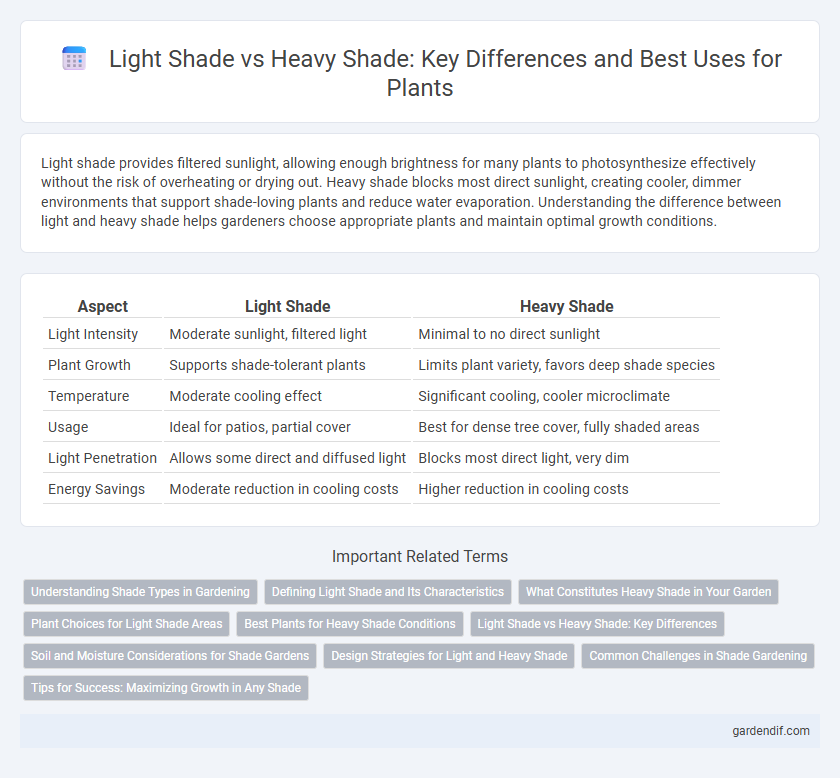
Light Shade vs Heavy Shade Illustration
Light shade provides filtered sunlight, allowing enough brightness for many plants to photosynthesize effectively without the risk of overheating or drying out. Heavy shade blocks most direct sunlight, creating cooler, dimmer environments that support shade-loving plants and reduce water evaporation. Understanding the difference between light and heavy shade helps gardeners choose appropriate plants and maintain optimal growth conditions.
Table of Comparison
| Aspect | Light Shade | Heavy Shade |
|---|---|---|
| Light Intensity | Moderate sunlight, filtered light | Minimal to no direct sunlight |
| Plant Growth | Supports shade-tolerant plants | Limits plant variety, favors deep shade species |
| Temperature | Moderate cooling effect | Significant cooling, cooler microclimate |
| Usage | Ideal for patios, partial cover | Best for dense tree cover, fully shaded areas |
| Light Penetration | Allows some direct and diffused light | Blocks most direct light, very dim |
| Energy Savings | Moderate reduction in cooling costs | Higher reduction in cooling costs |
Understanding Shade Types in Gardening
Light shade in gardening refers to areas receiving filtered or dappled sunlight for several hours a day, ideal for plants requiring partial sunlight such as ferns, hostas, and impatiens. Heavy shade denotes spots with dense canopy coverage or structures that block most sunlight, favoring shade-tolerant plants like mosses, liverworts, and certain woodland perennials. Understanding these distinctions helps gardeners select appropriate plant species and optimize growth conditions by matching light requirements to shade intensity.
Defining Light Shade and Its Characteristics
Light shade refers to areas where sunlight is filtered or partially blocked, producing dappled or indirect light rather than complete darkness. It typically supports plants that require moderate light levels, such as ferns and hostas, which thrive without full sun exposure. In light shade, temperatures remain somewhat cooler than in full sun, reducing heat stress on delicate foliage while providing enough luminosity for photosynthesis.
What Constitutes Heavy Shade in Your Garden
Heavy shade in your garden occurs when dense tree canopies or large structures block more than 75% of direct sunlight, creating consistently low light conditions. Plants in heavy shade experience significantly reduced photosynthesis, requiring shade-tolerant species adapted to minimal light, such as ferns, hostas, and certain ivy varieties. Understanding the degree of shade helps in selecting appropriate plants that thrive under limited sunlight and maintain garden health.
Plant Choices for Light Shade Areas
Plants suited for light shade areas thrive with filtered sunlight and partial protection from direct sun exposure, making species like ferns, hostas, and astilbes ideal selections. These plants require moderate moisture and can tolerate indirect light, promoting lush foliage and vibrant blooms under canopy trees or near buildings. Choosing varieties such as hellebores and lungwort enhances garden diversity while ensuring healthy growth in light shade conditions.
Best Plants for Heavy Shade Conditions
Best plants for heavy shade conditions include hostas, ferns, and astilbes, which thrive with minimal sunlight and provide lush greenery. These shade-tolerant plants have adapted to survive under dense canopy cover, making them ideal for areas receiving less than two hours of direct sunlight daily. Selecting species like Japanese painted ferns or foamflower ensures vibrant foliage and blooms despite deep shade environments.
Light Shade vs Heavy Shade: Key Differences
Light shade provides partial sunlight, supporting the growth of shade-tolerant plants by allowing filtered light that prevents overheating and dehydration. Heavy shade blocks most sunlight, creating a cooler, dim environment suitable for moss, ferns, and plants adapted to low light conditions. Understanding the key differences between light shade and heavy shade helps in selecting appropriate vegetation and optimizing garden design based on sunlight availability.
Soil and Moisture Considerations for Shade Gardens
Light shade gardens typically require well-drained, moderately moist soil with higher aeration to support plants that need partial sunlight and consistent moisture levels. Heavy shade environments often demand richer, organic soil with excellent moisture retention to compensate for limited photosynthesis and slower evaporation rates. Choosing soil amendments such as compost or mulch can regulate moisture, enhance soil structure, and promote healthier plant growth in varying shade intensities.
Design Strategies for Light and Heavy Shade
Design strategies for light shade emphasize the use of soft, translucent materials and muted color palettes to create a gentle, airy atmosphere that diffuses natural light without harsh shadows. For heavy shade, incorporating reflective surfaces, layered lighting, and vibrant, contrasting colors helps to brighten spaces and add depth, counteracting the dimness caused by thick foliage or dense architecture. Both approaches balance ambient light levels to enhance comfort and aesthetic appeal in shaded environments.
Common Challenges in Shade Gardening
Light shade gardens often face challenges with inconsistent sunlight, leading to uneven plant growth and struggles with flowering. Heavy shade creates a more demanding environment, where limited light restricts photosynthesis, resulting in slower growth and fewer blooming opportunities. Both conditions require careful plant selection and soil management to overcome issues related to moisture retention and pest control.
Tips for Success: Maximizing Growth in Any Shade
Plants growing in light shade benefit from filtered sunlight, promoting steady photosynthesis and preventing leaf scorch, making them ideal for species like ferns and hostas. In heavy shade, selecting shade-tolerant plants such as mosses and impatiens is crucial, alongside soil enrichment and strategic watering to compensate for limited light. Optimizing growth in any shade requires balancing moisture levels, choosing appropriate species, and ensuring proper soil aeration to enhance root development and overall plant health.
Light Shade vs Heavy Shade Infographic

 gardendif.com
gardendif.com